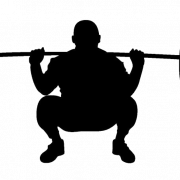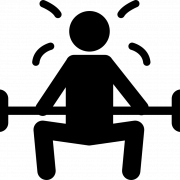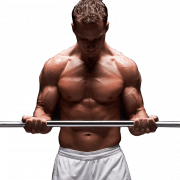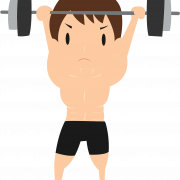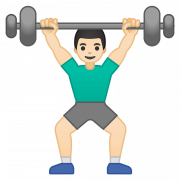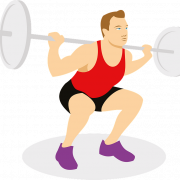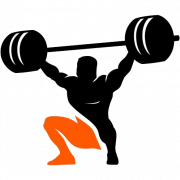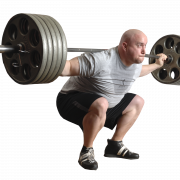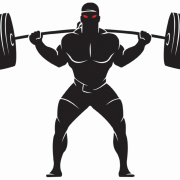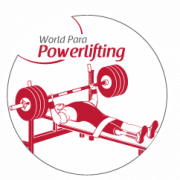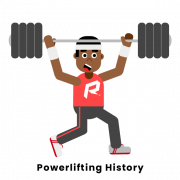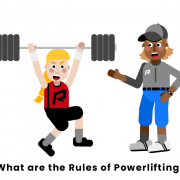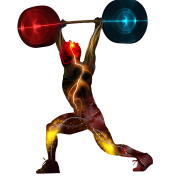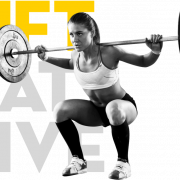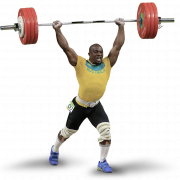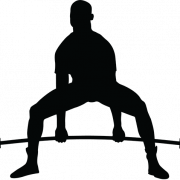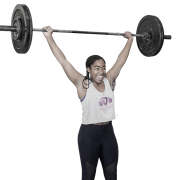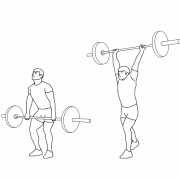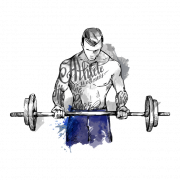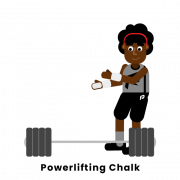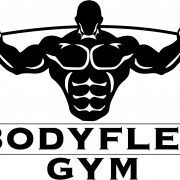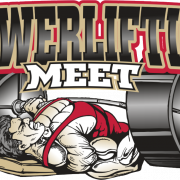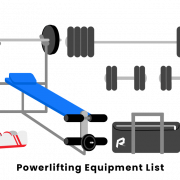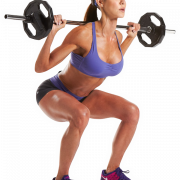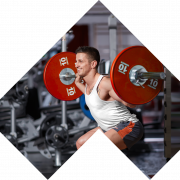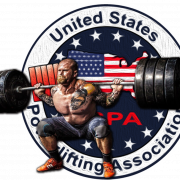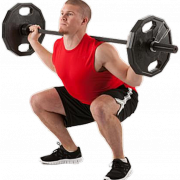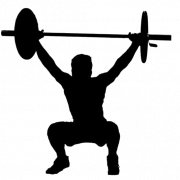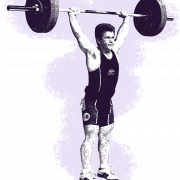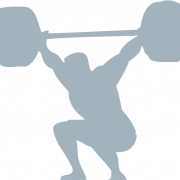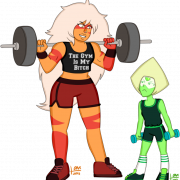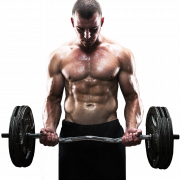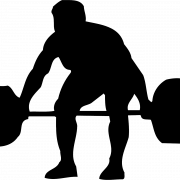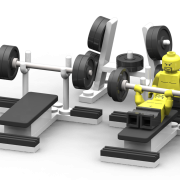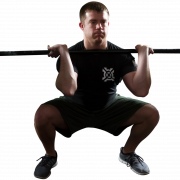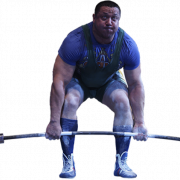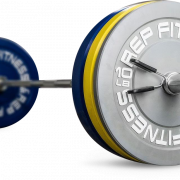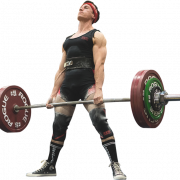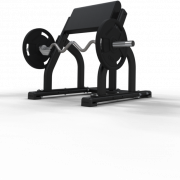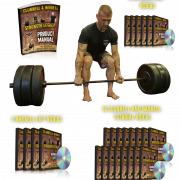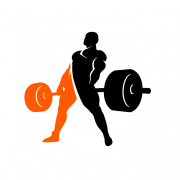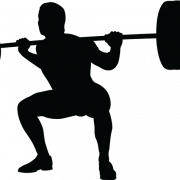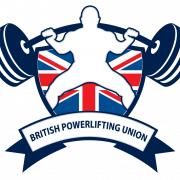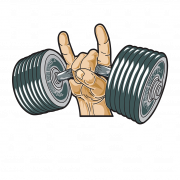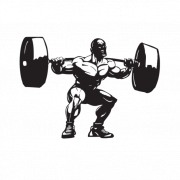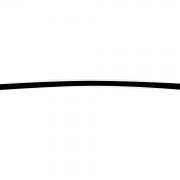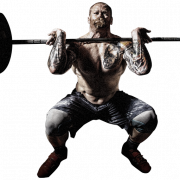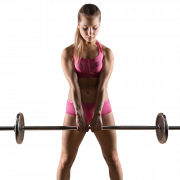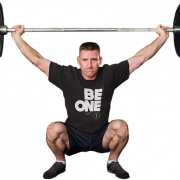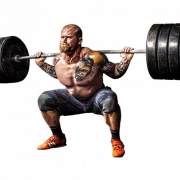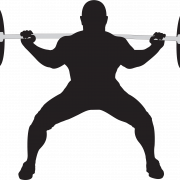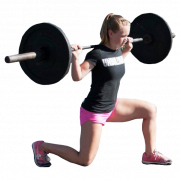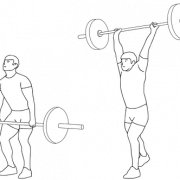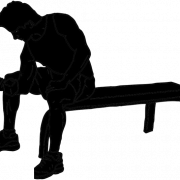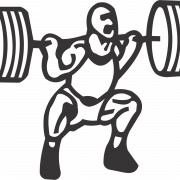Download top and best high-quality free Powerlifting PNG Transparent Images backgrounds available in various sizes. To view the full PNG size resolution click on any of the below image thumbnail.
License Info: Creative Commons 4.0 BY-NC
Powerlifting is a strength sport in which three attempts at maximum weight are made on three lifts: the squat, bench press, and deadlift. It includes the athlete performing a maximal weight single-lift effort using a barbell loaded with weight plates, similar to Olympic weightlifting. Powerlifting originated from a sport known as “odd lifts,” which utilized a similar three-attempt structure but a broader range of events, similar to strongman competition. Odd lifts were eventually standardized to the present three.
Lifts can be done equipped or unequipped in competition (in the IPF, this is referred as to as ‘traditional’ or ‘raw’ lifting). A supporting bench shirt, squat/deadlift suit, or briefs are used in this context. Knee wraps are allowed in certain federations only in the equipped division but not in the un-equipped division; in others, they are permitted in both the equipped and un-equipped divisions. Weight belts, knee sleeves, wrist wraps, and special footwear may be used, but they are not kept in mind when determining whether a lift is equipped or not.
Events taking place all around the world. Since 1984, powerlifting has become a Paralympic sport (bench press alone) and a World Games sport (under the IPF). Other federations that are not affiliated with the IPF have sanctioned local, national, and worldwide events.
The origins of powerlifting may be traced all the way back to ancient Greek and Persian strength training practices. Men lifted stones to show their strength and masculinity in ancient Greece, which gave rise to the concept of powerlifting. Since 1896, weightlifting has been a part of the Olympic Games. In the 1950s, contemporary sport was born in the United Kingdom and the United States. Previously, both nations’ weightlifting regulatory organizations accepted a variety of “strange lifts” for competition and record reasons.
Olympic weightlifting declined in popularity in the United States throughout the 1950s, whereas strength sports grew in popularity. The Olympic lifts Clean and Press, Snatch, and Clean and Jerk were not popular. The National Weightlifting Committee of the AAU agreed to start recognizing records for odd lifts in 1958. A national championship was planned for 1959, but it never materialized. Under the sponsorship of the York Barbell Company, the first true national “meet” was held in September 1964. York Barbell owner Bob Hoffman had been a longstanding opponent of the sport, but his firm was now producing powerlifting equipment to make up for lost sales on Olympic equipment.
For men with spinal cord injuries, certain powerlifting disciplines were added to the Tokyo Paralympic Games in 1964. With the passage of time, more lifting categories were introduced. Women were finally allowed to compete in powerlifting in the 2000 Paralympic Games in Sydney. Finally, both men and women were permitted to participate in all ten powerlifting weight classes.
Hoffman’s influence on Olympic lifting and his mostly Olympic-based publication Strength and Health came under increased pressure from Joe Weider’s group in the late 1950s. To counter Weider’s rising influence, Hoffman launched a new publication, Muscular Development, devoted to bodybuilding and the rapidly growing interest in odd lift contests.
John Grimek was the magazine’s first editor. Various odd lift events progressively evolved into the specialized lifts of the bench press, squat, and deadlift in the late 1950s and early 1960s, and they were performed in that order. Hoffman became more important in the growth of this new lifting sport, and in 1964 he created the Weightlifting Tournament of America, which was effectively the first national championship in the United States.
The earliest USA National Championships were held in 1965. Lifting in Britain had divisions at the same time period. In the late 1950s, a breakaway group named the Society of Amateur Weightlifters was created to cater to the needs of lifters who were not especially interested in Olympic lifting since members of the controlling body (BAWLA) were primarily concerned with the growth of Olympic lifting.
Download Powerlifting PNG images transparent gallery.
- Gym Powerlifting PNG File
Resolution: 854 × 451
Size: 47 KB
Image Format: .png
Download
- Gym Powerlifting PNG HD Image
Resolution: 980 × 852
Size: 24 KB
Image Format: .png
Download
- Gym Powerlifting PNG Pic
Resolution: 1439 × 800
Size: 171 KB
Image Format: .png
Download
- Gym Powerlifting PNG Download Image
Resolution: 1652 × 1920
Size: 58 KB
Image Format: .png
Download
- Gym Powerlifting PNG High Quality Image
Resolution: 800 × 800
Size: 24 KB
Image Format: .png
Download
- Gym Powerlifting PNG Images
Resolution: 800 × 687
Size: 37 KB
Image Format: .png
Download
- Gym Powerlifting PNG Image File
Resolution: 920 × 498
Size: 70 KB
Image Format: .png
Download
- Gym Powerlifting PNG Photo
Resolution: 850 × 729
Size: 55 KB
Image Format: .png
Download
- Gym Powerlifting PNG Image HD
Resolution: 2258 × 1500
Size: 1486 KB
Image Format: .png
Download
- Gym Powerlifting PNG File Download Free
Resolution: 990 × 791
Size: 359 KB
Image Format: .png
Download
- Gym Powerlifting PNG Transparent HD Photo
Resolution: 800 × 465
Size: 21 KB
Image Format: .png
Download
- Powerlifting Workout
Resolution: 1200 × 1200
Size: 295 KB
Image Format: .png
Download
- Powerlifting Workout PNG
Resolution: 992 × 621
Size: 27 KB
Image Format: .png
Download
- Powerlifting Workout PNG Image
Resolution: 992 × 621
Size: 45 KB
Image Format: .png
Download
- Powerlifting Workout Transparent
Resolution: 2617 × 2284
Size: 67 KB
Image Format: .png
Download
- Powerlifting Workout PNG Clipart
Resolution: 1200 × 1200
Size: 22 KB
Image Format: .png
Download
- Powerlifting Workout PNG Free Download
Resolution: 990 × 648
Size: 181 KB
Image Format: .png
Download
- Powerlifting Workout PNG Picture
Resolution: 720 × 720
Size: 313 KB
Image Format: .png
Download
- Powerlifting Workout PNG Free Image
Resolution: 905 × 610
Size: 205 KB
Image Format: .png
Download
- Powerlifting Workout PNG File
Resolution: 715 × 715
Size: 247 KB
Image Format: .png
Download
- Powerlifting Workout PNG HD Image
Resolution: 1300 × 1010
Size: 537 KB
Image Format: .png
Download
- Powerlifting Workout PNG Pic
Resolution: 800 × 478
Size: 11 KB
Image Format: .png
Download
- Powerlifting Workout PNG Download Image
Resolution: 1080 × 1080
Size: 489 KB
Image Format: .png
Download
- Powerlifting Workout PNG High Quality Image
Resolution: 1280 × 509
Size: 102 KB
Image Format: .png
Download
- Powerlifting Workout PNG Images
Resolution: 2411 × 2042
Size: 64 KB
Image Format: .png
Download
- Powerlifting Workout PNG Image File
Resolution: 2372 × 1852
Size: 72 KB
Image Format: .png
Download
- Powerlifting Workout PNG Photo
Resolution: 650 × 650
Size: 241 KB
Image Format: .png
Download
- Powerlifting Workout PNG Image HD
Resolution: 2022 × 1711
Size: 43 KB
Image Format: .png
Download
- Powerlifting Workout PNG File Download Free
Resolution: 992 × 621
Size: 11 KB
Image Format: .png
Download
- Powerlifting Workout PNG Transparent HD Photo
Resolution: 1501 × 896
Size: 157 KB
Image Format: .png
Download
- Powerlifting Equipment PNG Image
Resolution: 1023 × 607
Size: 389 KB
Image Format: .png
Download
- Powerlifting Equipment Transparent
Resolution: 992 × 621
Size: 18 KB
Image Format: .png
Download
- Powerlifting PNG Photo
Resolution: 600 × 778
Size: 582 KB
Image Format: .png
Download
- Powerlifting
Resolution: 1024 × 545
Size: 933 KB
Image Format: .png
Download
- Powerlifting PNG Clipart
Resolution: 1560 × 1322
Size: 1737 KB
Image Format: .png
Download
- Powerlifting PNG HD Image
Resolution: 1051 × 834
Size: 1364 KB
Image Format: .png
Download
- Powerlifting PNG Images
Resolution: 761 × 791
Size: 759 KB
Image Format: .png
Download
- Silhouette Powerlifting PNG Free Download
Resolution: 934 × 534
Size: 65 KB
Image Format: .png
Download
- Powerlifting PNG Image File
Resolution: 1371 × 1668
Size: 980 KB
Image Format: .png
Download
- Vector Powerlifting PNG Picture
Resolution: 661 × 586
Size: 19 KB
Image Format: .png
Download
- Powerlifting PNG Image HD
Resolution: 854 × 895
Size: 313 KB
Image Format: .png
Download
- Powerlifting PNG
Resolution: 1000 × 1045
Size: 1080 KB
Image Format: .png
Download
- Silhouette Powerlifting
Resolution: 1846 × 1275
Size: 47 KB
Image Format: .png
Download
- Vector Powerlifting
Resolution: 907 × 1173
Size: 64 KB
Image Format: .png
Download
- Powerlifting Equipment
Resolution: 960 × 540
Size: 346 KB
Image Format: .png
Download
- Powerlifting PNG Image
Resolution: 2996 × 1579
Size: 1628 KB
Image Format: .png
Download
- Powerlifting Transparent
Resolution: 850 × 506
Size: 264 KB
Image Format: .png
Download
- Powerlifting Equipment PNG
Resolution: 1053 × 645
Size: 564 KB
Image Format: .png
Download
- Powerlifting PNG Free Download
Resolution: 752 × 621
Size: 333 KB
Image Format: .png
Download
- Powerlifting PNG Picture
Resolution: 1025 × 616
Size: 199 KB
Image Format: .png
Download
- Silhouette Powerlifting PNG
Resolution: 772 × 990
Size: 24 KB
Image Format: .png
Download
- Powerlifting PNG Free Image
Resolution: 1057 × 1871
Size: 1949 KB
Image Format: .png
Download
- Vector Powerlifting PNG
Resolution: 2081 × 1388
Size: 162 KB
Image Format: .png
Download
- Silhouette Powerlifting PNG Image
Resolution: 703 × 801
Size: 16 KB
Image Format: .png
Download
- Powerlifting PNG File
Resolution: 699 × 699
Size: 18 KB
Image Format: .png
Download
- Silhouette Powerlifting Transparent
Resolution: 800 × 475
Size: 16 KB
Image Format: .png
Download
- Silhouette Powerlifting PNG Clipart
Resolution: 1450 × 980
Size: 27 KB
Image Format: .png
Download
- Powerlifting PNG Pic
Resolution: 1102 × 931
Size: 105 KB
Image Format: .png
Download
- Vector Powerlifting PNG Image
Resolution: 1189 × 1093
Size: 499 KB
Image Format: .png
Download
- Vector Powerlifting Transparent
Resolution: 850 × 587
Size: 101 KB
Image Format: .png
Download
- Vector Powerlifting PNG Clipart
Resolution: 1920 × 960
Size: 105 KB
Image Format: .png
Download
- Powerlifting PNG Download Image
Resolution: 931 × 512
Size: 309 KB
Image Format: .png
Download
- Powerlifting PNG High Quality Image
Resolution: 1268 × 1000
Size: 705 KB
Image Format: .png
Download
- Vector Powerlifting PNG Free Download
Resolution: 765 × 509
Size: 29 KB
Image Format: .png
Download
- Gym Powerlifting
Resolution: 800 × 505
Size: 265 KB
Image Format: .png
Download
- Gym Powerlifting PNG
Resolution: 850 × 545
Size: 257 KB
Image Format: .png
Download
- Gym Powerlifting PNG Image
Resolution: 4478 × 2837
Size: 292 KB
Image Format: .png
Download
- Gym Powerlifting Transparent
Resolution: 996 × 901
Size: 393 KB
Image Format: .png
Download
- Gym Powerlifting PNG Clipart
Resolution: 860 × 573
Size: 203 KB
Image Format: .png
Download
- Gym Powerlifting PNG Free Download
Resolution: 961 × 332
Size: 100 KB
Image Format: .png
Download
- Gym Powerlifting PNG Picture
Resolution: 934 × 534
Size: 125 KB
Image Format: .png
Download
- Gym Powerlifting PNG Free Image
Resolution: 1319 × 1095
Size: 122 KB
Image Format: .png
Download
